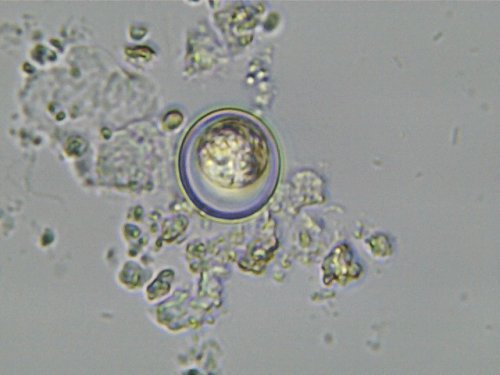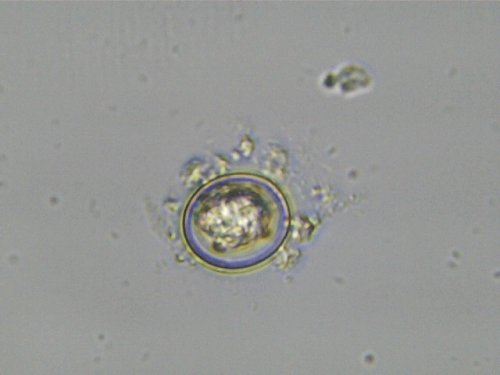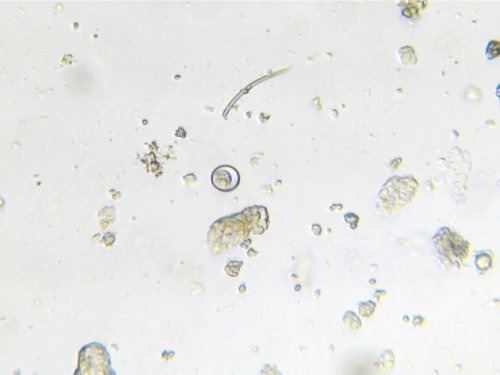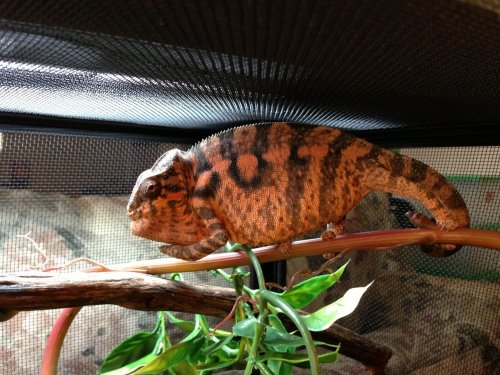NHenn
Avid Member
About a month and a half ago I purchased my latest addition to our chameleon family, a 10 month old Nosy Be female Panther named Naila. As she was from a different breeder than my other panthers, I kept her and her cage separate from all the other chameleons encase she happen to have something that I didn’t want the others possibility picking up. As you will see, I'm very glad I did this.
It was right around that time I found a post by Dez about performing your own fecal floats to test for parasites. https://www.chameleonforums.com/how-do-fecal-float-video-111996/. After looking into the total cost of materials verse the cost of multiple tests through my vet ($28 each), it made sense to purchase the equipment and perform my own and only take samples to the vet if something looked fishy or there were obvious parasites.
So, I obtained a fresh sample from all my chameleons and followed Dez’s instructions. Everyone looked to be very clean but my one male panther and Naila. My male ended up being clean but I did believed that Naila had Coccidia . Dez was more than helpful in looking at some of the pictures I took and giving me her opinion on what it might be and possible treatments if it is Coccidia. If it wasn’t for Dessirae, I would have most likely missed the fact that Naila had Coccidia and it could have easily been transferred to my other chameleons.
. Dez was more than helpful in looking at some of the pictures I took and giving me her opinion on what it might be and possible treatments if it is Coccidia. If it wasn’t for Dessirae, I would have most likely missed the fact that Naila had Coccidia and it could have easily been transferred to my other chameleons.
Below are some pictures of the slides showing what I believed to be Coccidia as it wasn’t confirmed by the vet at that point.



Naila went to the vet on September 10, I brought along some of the above pictures and some additional resources that were recommended to me by Dessirae about Coccidia and possible treatment. This being the main one https://www.chameleonforums.com/chameleons-coccidia-ponazuril-offers-new-hope-16409/ .
I discussed possible treatments with my vet and we both agreed upon giving Ponazuril a shot. As he never prescribed this medication for a reptile before (Ponazuril is commonly used in horses, not reptiles) he had to contact a compounding pharmacy to obtain some. Diamond Back Drugs in Scottsdale, Arizona was the pharmacy of choice and they shipped the prescription directly to me for a total (including shipping) of $33.95. It was a bit steeper in price than the standard treatment but I felt it was worth the extra amount to try and use a drug in hopes that would not have the negative affects on her like the commonly used drug for treatment Albon would.
I followed the suggested treatment schedule of the above thread but of course utilized my vet’s prescribed dosage amounts as my female was about half the size of the male in the thread above and my Ponazuril’s suspension was only 5MG/ML and not 30MG/ML like in the thread.
September 17, the Ponazuril arrived and I began the treatment of 3 days on, 7 days off, 3 days on, 7 days off. As Naila is far from being a lovey, sweet girl, it was easy to administer the medication orally as her mouth is always open to bite your hand should it get close to her.
Same dosage for the next two days (day 2-3). However, unlike in the thread above, Naila did lose her appetite on the third day. She went from eating 8-10 crickets a day to maybe 1-2 a day for the next 6 days. Day 9, her appetite started to come back and on Day 10 she was eating all 8-10 crickets again.
I was finally able to perform a fecal float on day 7 as she hasn’t gone in a few days due to little eating. Day 7 slide contained about the same number of Coccidia as the original slide which was upsetting as I wanted to see some improvement by that point. On Day 9, I was able to obtain another sample and do another test. I counted about half the amount of Coccidia parasites from the previous test on day 7. That was excellent news and I was very pleased to know it was working but I still felt bad knowing that her medication will start again in two days and most likely her eating will stop once again.
On day 10 I took apart her cage and did a complete clean on everything! Top to bottom as Coccidia can re-infect very easily if her cage isn’t clean. I also took some additional measures to ensure the cage remained as clean as possible and to also prevent the transfer of the parasite to my other chameleons.
1. Her and her cage remained isolated from the other chameleons and cages at all times.
2. All her plants in the cage were fake for easy soaking and cleaning.
3. I didn’t have any dirt in her cage during this treatment either as Coccidia can living in soil for up to 6 months so her laying bin was removed day 1 and all the dirt was discarded.
4. As soon as I would notice stool in her cage it was immediately removed.
5. I would wipe the bottom of her cage with Lysol wipes every day and immediately after removing her stool.
6. I would wash and or Purell my hands after I did anything with her cage. I would never clean her cage and then immediately go to another chameleon’s cage without first ensuring my hands were properly cleaned.
7. When she had extra crickets in her cage at night, I would remove them and discard them. I didn’t place them back in with my other crickets.
On days 11 & 12 I tried injecting the second round of medication into hornworms as her appetite was back and I didn’t want to add more stress to her by having her open her mouth to administer it. That worked perfectly until the last day, day 13 of her medication as her appetite dropped and she wanted nothing to do with a large hornworm so I had to give her the last dosage orally.
I was heading to the vet already for my carpet chameleon on day 12 of Naila’s treatment and she left me a fresh sample so I took that with me to get another official test performed by the vet. I found out on day 14 that the test came back negative and she was completely free of parasites!!!!! I was super excited at this point but still was keeping a close eye on the little girl as her eating was not back to normal yet. On day 19, she finally started to eat more and actually went to the bathroom twice that day as she didn’t go in a few days again. I performed my last test utilizing a little sample from both stools to perform a more accurate test and the slide was completely clean of Coccidia.
I took apart her cage again and did another final 100% overall clean to make sure that re-infection does not occur. Yesterday, day 21 was the last day of her treatment and she is back to eating normal again and hopefully will remain Coccidia and all other parasite free for the rest of her life!
A grumpy but parasite free Naila!

I hope this helps shed some light on Coccidia and one possible course of treatment for anyone who might be currently battling with this parasite or who might have the unfortunate run in with it in the future. Again, special thanks to Dessirae (Dez) couldn’t have done it without you!
Nick
It was right around that time I found a post by Dez about performing your own fecal floats to test for parasites. https://www.chameleonforums.com/how-do-fecal-float-video-111996/. After looking into the total cost of materials verse the cost of multiple tests through my vet ($28 each), it made sense to purchase the equipment and perform my own and only take samples to the vet if something looked fishy or there were obvious parasites.
So, I obtained a fresh sample from all my chameleons and followed Dez’s instructions. Everyone looked to be very clean but my one male panther and Naila. My male ended up being clean but I did believed that Naila had Coccidia
Below are some pictures of the slides showing what I believed to be Coccidia as it wasn’t confirmed by the vet at that point.



Naila went to the vet on September 10, I brought along some of the above pictures and some additional resources that were recommended to me by Dessirae about Coccidia and possible treatment. This being the main one https://www.chameleonforums.com/chameleons-coccidia-ponazuril-offers-new-hope-16409/ .
I discussed possible treatments with my vet and we both agreed upon giving Ponazuril a shot. As he never prescribed this medication for a reptile before (Ponazuril is commonly used in horses, not reptiles) he had to contact a compounding pharmacy to obtain some. Diamond Back Drugs in Scottsdale, Arizona was the pharmacy of choice and they shipped the prescription directly to me for a total (including shipping) of $33.95. It was a bit steeper in price than the standard treatment but I felt it was worth the extra amount to try and use a drug in hopes that would not have the negative affects on her like the commonly used drug for treatment Albon would.
I followed the suggested treatment schedule of the above thread but of course utilized my vet’s prescribed dosage amounts as my female was about half the size of the male in the thread above and my Ponazuril’s suspension was only 5MG/ML and not 30MG/ML like in the thread.
September 17, the Ponazuril arrived and I began the treatment of 3 days on, 7 days off, 3 days on, 7 days off. As Naila is far from being a lovey, sweet girl, it was easy to administer the medication orally as her mouth is always open to bite your hand should it get close to her.
Same dosage for the next two days (day 2-3). However, unlike in the thread above, Naila did lose her appetite on the third day. She went from eating 8-10 crickets a day to maybe 1-2 a day for the next 6 days. Day 9, her appetite started to come back and on Day 10 she was eating all 8-10 crickets again.
I was finally able to perform a fecal float on day 7 as she hasn’t gone in a few days due to little eating. Day 7 slide contained about the same number of Coccidia as the original slide which was upsetting as I wanted to see some improvement by that point. On Day 9, I was able to obtain another sample and do another test. I counted about half the amount of Coccidia parasites from the previous test on day 7. That was excellent news and I was very pleased to know it was working but I still felt bad knowing that her medication will start again in two days and most likely her eating will stop once again.
On day 10 I took apart her cage and did a complete clean on everything! Top to bottom as Coccidia can re-infect very easily if her cage isn’t clean. I also took some additional measures to ensure the cage remained as clean as possible and to also prevent the transfer of the parasite to my other chameleons.
1. Her and her cage remained isolated from the other chameleons and cages at all times.
2. All her plants in the cage were fake for easy soaking and cleaning.
3. I didn’t have any dirt in her cage during this treatment either as Coccidia can living in soil for up to 6 months so her laying bin was removed day 1 and all the dirt was discarded.
4. As soon as I would notice stool in her cage it was immediately removed.
5. I would wipe the bottom of her cage with Lysol wipes every day and immediately after removing her stool.
6. I would wash and or Purell my hands after I did anything with her cage. I would never clean her cage and then immediately go to another chameleon’s cage without first ensuring my hands were properly cleaned.
7. When she had extra crickets in her cage at night, I would remove them and discard them. I didn’t place them back in with my other crickets.
On days 11 & 12 I tried injecting the second round of medication into hornworms as her appetite was back and I didn’t want to add more stress to her by having her open her mouth to administer it. That worked perfectly until the last day, day 13 of her medication as her appetite dropped and she wanted nothing to do with a large hornworm so I had to give her the last dosage orally.
I was heading to the vet already for my carpet chameleon on day 12 of Naila’s treatment and she left me a fresh sample so I took that with me to get another official test performed by the vet. I found out on day 14 that the test came back negative and she was completely free of parasites!!!!! I was super excited at this point but still was keeping a close eye on the little girl as her eating was not back to normal yet. On day 19, she finally started to eat more and actually went to the bathroom twice that day as she didn’t go in a few days again. I performed my last test utilizing a little sample from both stools to perform a more accurate test and the slide was completely clean of Coccidia.
I took apart her cage again and did another final 100% overall clean to make sure that re-infection does not occur. Yesterday, day 21 was the last day of her treatment and she is back to eating normal again and hopefully will remain Coccidia and all other parasite free for the rest of her life!
A grumpy but parasite free Naila!

I hope this helps shed some light on Coccidia and one possible course of treatment for anyone who might be currently battling with this parasite or who might have the unfortunate run in with it in the future. Again, special thanks to Dessirae (Dez) couldn’t have done it without you!
Nick










